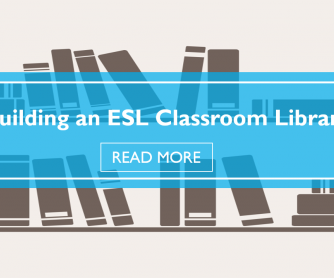
A key component of ESL instruction is getting students to read and comprehend texts in English. In the classroom, students encounter texts in the form of articles and stories and textbook and handouts created by teachers. They see texts on PowerPoint slides and other screens projected in their classrooms. Occasionally, they'll read a book with other students of the classroom. However, many students rarely pick up reading materials in English on their own. Building a classroom library can be a way to entice students to find something new to read and encourage them to read on their own time.
Setting Up the Library
For teachers who don't have a regular classroom, building a classroom library can be a challenge. If you have a place to store a cart, you can fill one with books and other materials for students to read and bring it with you when you teach a class. If you teach online, you can create a digital library or a page filled with links to poems, stories, articles, and other materials for students to read. In an actual classroom, you can store your library on a series of bookshelves, organizing resources by level, topic, or genre to help students easily find something to read.
Choosing Materials for the Library
A classroom library should contain a variety of materials. You may choose to have a large selection of materials that stays the same year-round or you may choose to pull out certain books and other resources that relate to the subjects you are talking about in class. Regardless of how you choose to structure your library, you should be sure to choose resources that:
- cover a range of reading levels
- are a range of lengths (short, long, medium)
- come in a variety of formats
- consider multiple perspectives
Students in your classes likely read at different levels. You will want to have a range of reading materials from short picture books to lengthy novels for students to choose from. However, you should not force students to choose books at their level. Keep in mind that any reading practice can be beneficial, so an advanced student may benefit from reading a picture book even though it is below level. Similarly, a lower-level student may enjoy an advanced book if it covers a topic in which he/she is interested. A student does not have to read the book word for word to get something from it.
When building a classroom library, think beyond traditional books. You want to include a mix of fiction and non-fiction. You also want to include a variety of resources. For example, you may want to add magazines, brochures, and books of poetry to your classroom library. You can even fill binders with mini posters, advertisements, letters, or other texts you come across.
Getting Materials for Your Classroom Library
A classroom library does not have to contain the latest titles. In fact, it's a great place for students to discover more unique titles. When filling your classroom library, look for books at library sales, used book sales, and thrift stores. Books and magazines can usually be purchased pretty cheaply from these places. You can also ask friends and family members to go through their bookshelves and see if they have any books or magazines they would like to donate to your classroom. Students can bring in books from home or swap books that they own for new books from your classroom library. You just want to be sure to preview any books students bring in.
Don't worry about filling your library right away. It's okay to add a few books at a time and build your library throughout the school year.
Letting Students Access Materials
Some teachers have time to create elaborate classroom library systems where they track each book and how long it has been out. Other teachers simply rely on the honor system, trusting students to borrow books and return them when they finish reading them. The latter is the easiest method, but you should be prepared to lose a few books that students forget to return. You may also want to track more popular books and set time limits on how long students can keep them so all students can get a chance to read them.
You can choose whether to require students to read books from your library or just let them choose books if they desire. You may also have early finishers choose a book and read silently until other students finish.
School libraries and local libraries are great resources for students, but a classroom library can be a great resource as well. Students can find tons of unique texts to read without even leaving your classroom.
canP.S. If you enjoyed this article, please help spread it by clicking one of those sharing buttons below. And if you are interested in more, you should follow our Facebook page where we share more about creative, non-boring ways to teach English.








